Advertising and Promotion: Methods, Regulations, and Strategies Report
VerifiedAdded on 2021/01/18
|29
|8764
|146
Report
AI Summary
This report delves into the critical role of advertising and promotion in contemporary business, emphasizing their significance in achieving desired goals and fostering customer engagement. It explores the application of marketing communication, including the AIDA model and communication mix, to establish and maintain brand visibility and customer loyalty. The report analyzes the structure of the advertising and promotion industry, outlining the roles of advertisers, agencies, facilitators, media organizations, and target audiences. Furthermore, it examines the regulations governing promotional activities in the UK, including relevant acts and the self-regulatory system. The content covers various aspects of sales promotion, direct marketing, and consumer protection, offering a comprehensive overview of the strategies and legal frameworks essential for effective advertising and promotional campaigns. The report aims to educate learners on the effectiveness of advertising and promotion, its methods and planning, in marketing their business’ product or service to the expected customers.

APB
Advertising & Promotions in Business
By _____________________________
1
Advertising & Promotions in Business
By _____________________________
1
Paraphrase This Document
Need a fresh take? Get an instant paraphrase of this document with our AI Paraphraser
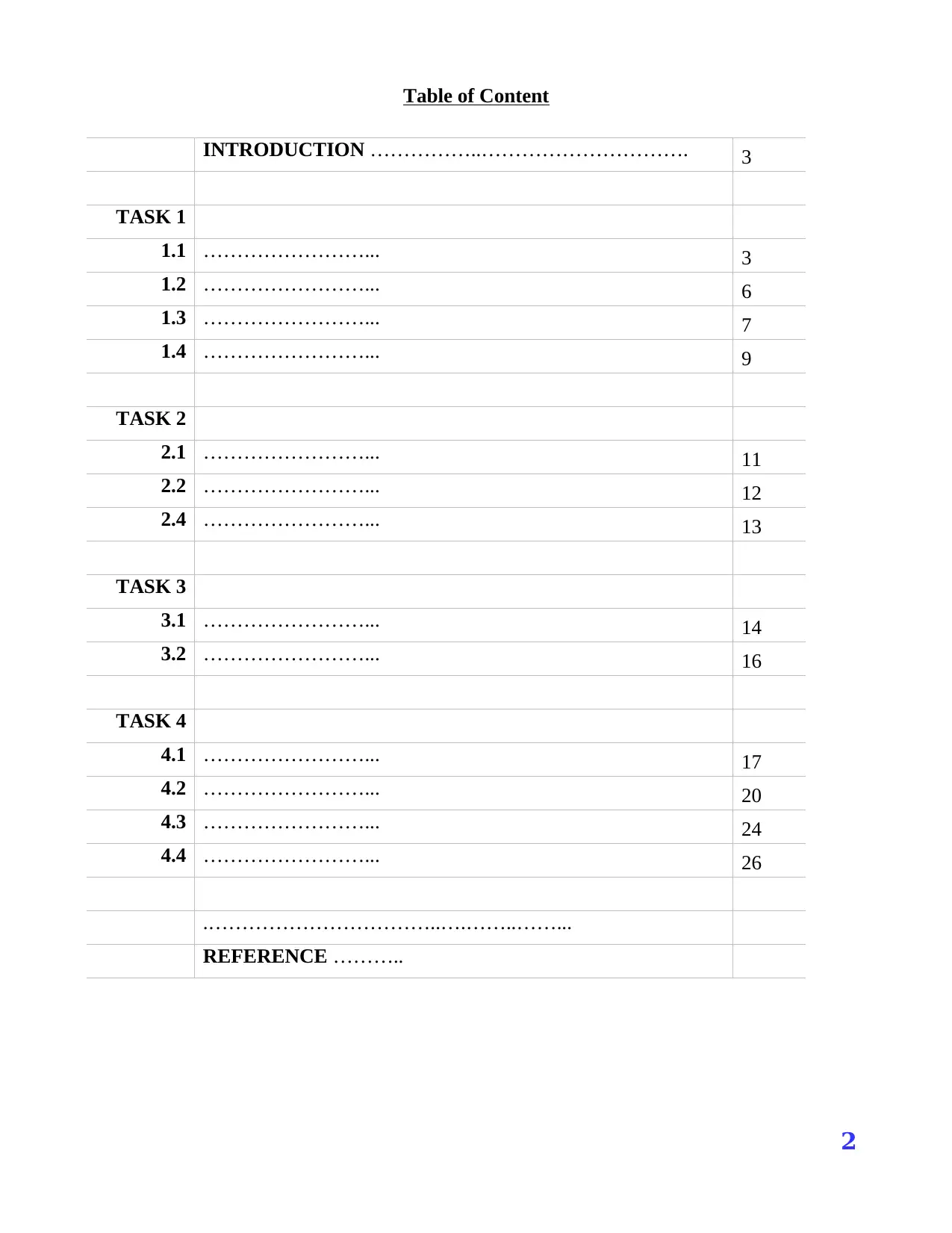
Table of Content
INTRODUCTION ……………..………………………….
…………………………. 3
TASK 1
1.1 ……………………...
………………………………………………………………… 3
1.2 ……………………...
………………………………………………………………… 6
1.3 ……………………...
………………………………………………………………… 7
1.4 ……………………...
………………………………………………………………… 9
TASK 2
2.1 ……………………...
………………………………………………………………… 11
2.2 ……………………...
………………………………………………………………… 12
2.4 ……………………...
………………………………………………………………… 13
TASK 3
3.1 ……………………...
………………………………………………………………… 14
3.2 ……………………...
………………………………………………………………… 16
TASK 4
4.1 ……………………...
………………………………………………………………… 17
4.2 ……………………...
………………………………………………………………… 20
4.3 ……………………...
………………………………………………………………… 24
4.4 ……………………...
………………………………………………………………… 26
.……………………………..….……..……...
…………………….….REFERENCE ………..
………………………………………….………..……………..
2
INTRODUCTION ……………..………………………….
…………………………. 3
TASK 1
1.1 ……………………...
………………………………………………………………… 3
1.2 ……………………...
………………………………………………………………… 6
1.3 ……………………...
………………………………………………………………… 7
1.4 ……………………...
………………………………………………………………… 9
TASK 2
2.1 ……………………...
………………………………………………………………… 11
2.2 ……………………...
………………………………………………………………… 12
2.4 ……………………...
………………………………………………………………… 13
TASK 3
3.1 ……………………...
………………………………………………………………… 14
3.2 ……………………...
………………………………………………………………… 16
TASK 4
4.1 ……………………...
………………………………………………………………… 17
4.2 ……………………...
………………………………………………………………… 20
4.3 ……………………...
………………………………………………………………… 24
4.4 ……………………...
………………………………………………………………… 26
.……………………………..….……..……...
…………………….….REFERENCE ………..
………………………………………….………..……………..
2
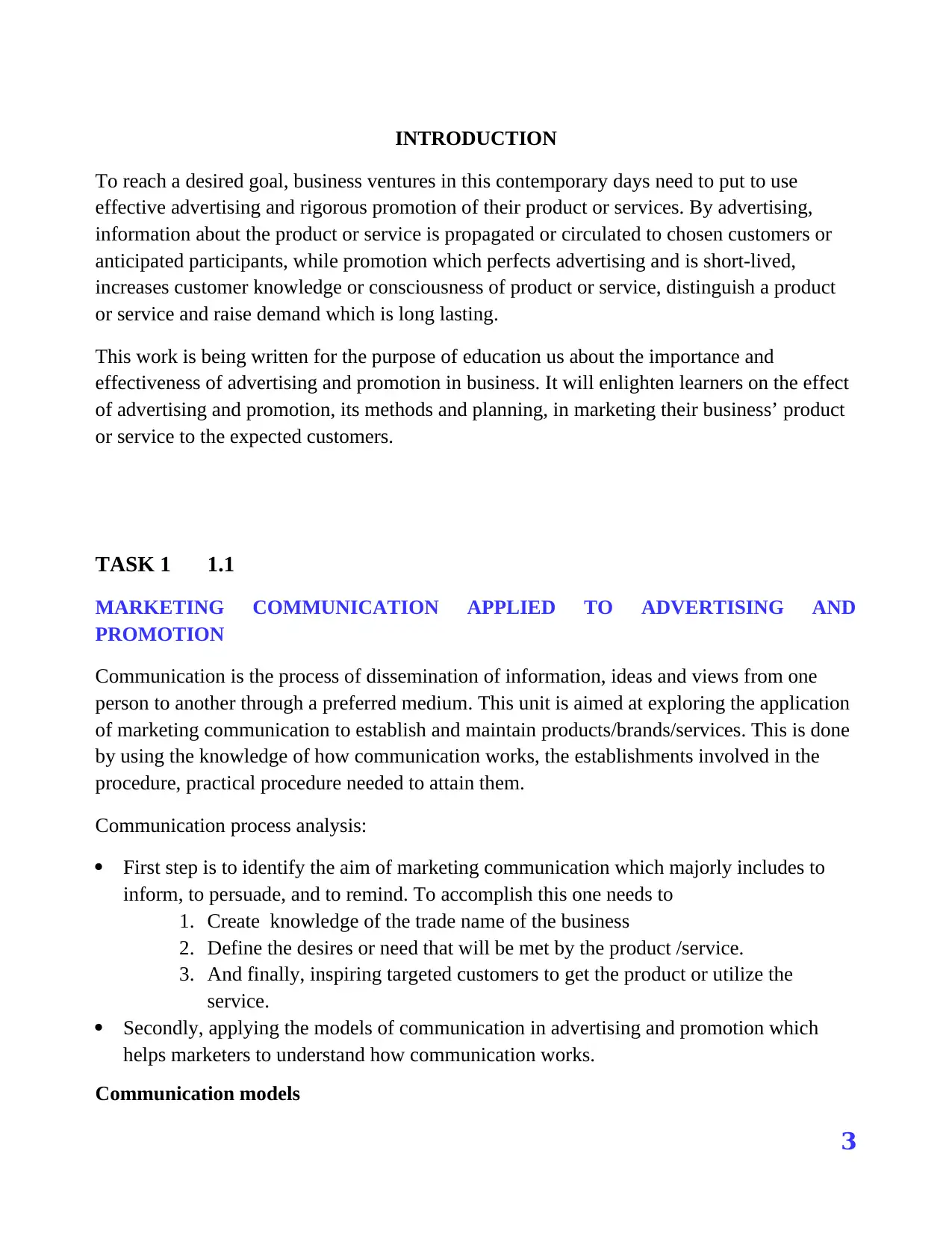
INTRODUCTION
To reach a desired goal, business ventures in this contemporary days need to put to use
effective advertising and rigorous promotion of their product or services. By advertising,
information about the product or service is propagated or circulated to chosen customers or
anticipated participants, while promotion which perfects advertising and is short-lived,
increases customer knowledge or consciousness of product or service, distinguish a product
or service and raise demand which is long lasting.
This work is being written for the purpose of education us about the importance and
effectiveness of advertising and promotion in business. It will enlighten learners on the effect
of advertising and promotion, its methods and planning, in marketing their business’ product
or service to the expected customers.
TASK 1 1.1
MARKETING COMMUNICATION APPLIED TO ADVERTISING AND
PROMOTION
Communication is the process of dissemination of information, ideas and views from one
person to another through a preferred medium. This unit is aimed at exploring the application
of marketing communication to establish and maintain products/brands/services. This is done
by using the knowledge of how communication works, the establishments involved in the
procedure, practical procedure needed to attain them.
Communication process analysis:
First step is to identify the aim of marketing communication which majorly includes to
inform, to persuade, and to remind. To accomplish this one needs to
1. Create knowledge of the trade name of the business
2. Define the desires or need that will be met by the product /service.
3. And finally, inspiring targeted customers to get the product or utilize the
service.
Secondly, applying the models of communication in advertising and promotion which
helps marketers to understand how communication works.
Communication models
3
To reach a desired goal, business ventures in this contemporary days need to put to use
effective advertising and rigorous promotion of their product or services. By advertising,
information about the product or service is propagated or circulated to chosen customers or
anticipated participants, while promotion which perfects advertising and is short-lived,
increases customer knowledge or consciousness of product or service, distinguish a product
or service and raise demand which is long lasting.
This work is being written for the purpose of education us about the importance and
effectiveness of advertising and promotion in business. It will enlighten learners on the effect
of advertising and promotion, its methods and planning, in marketing their business’ product
or service to the expected customers.
TASK 1 1.1
MARKETING COMMUNICATION APPLIED TO ADVERTISING AND
PROMOTION
Communication is the process of dissemination of information, ideas and views from one
person to another through a preferred medium. This unit is aimed at exploring the application
of marketing communication to establish and maintain products/brands/services. This is done
by using the knowledge of how communication works, the establishments involved in the
procedure, practical procedure needed to attain them.
Communication process analysis:
First step is to identify the aim of marketing communication which majorly includes to
inform, to persuade, and to remind. To accomplish this one needs to
1. Create knowledge of the trade name of the business
2. Define the desires or need that will be met by the product /service.
3. And finally, inspiring targeted customers to get the product or utilize the
service.
Secondly, applying the models of communication in advertising and promotion which
helps marketers to understand how communication works.
Communication models
3
⊘ This is a preview!⊘
Do you want full access?
Subscribe today to unlock all pages.

Trusted by 1+ million students worldwide
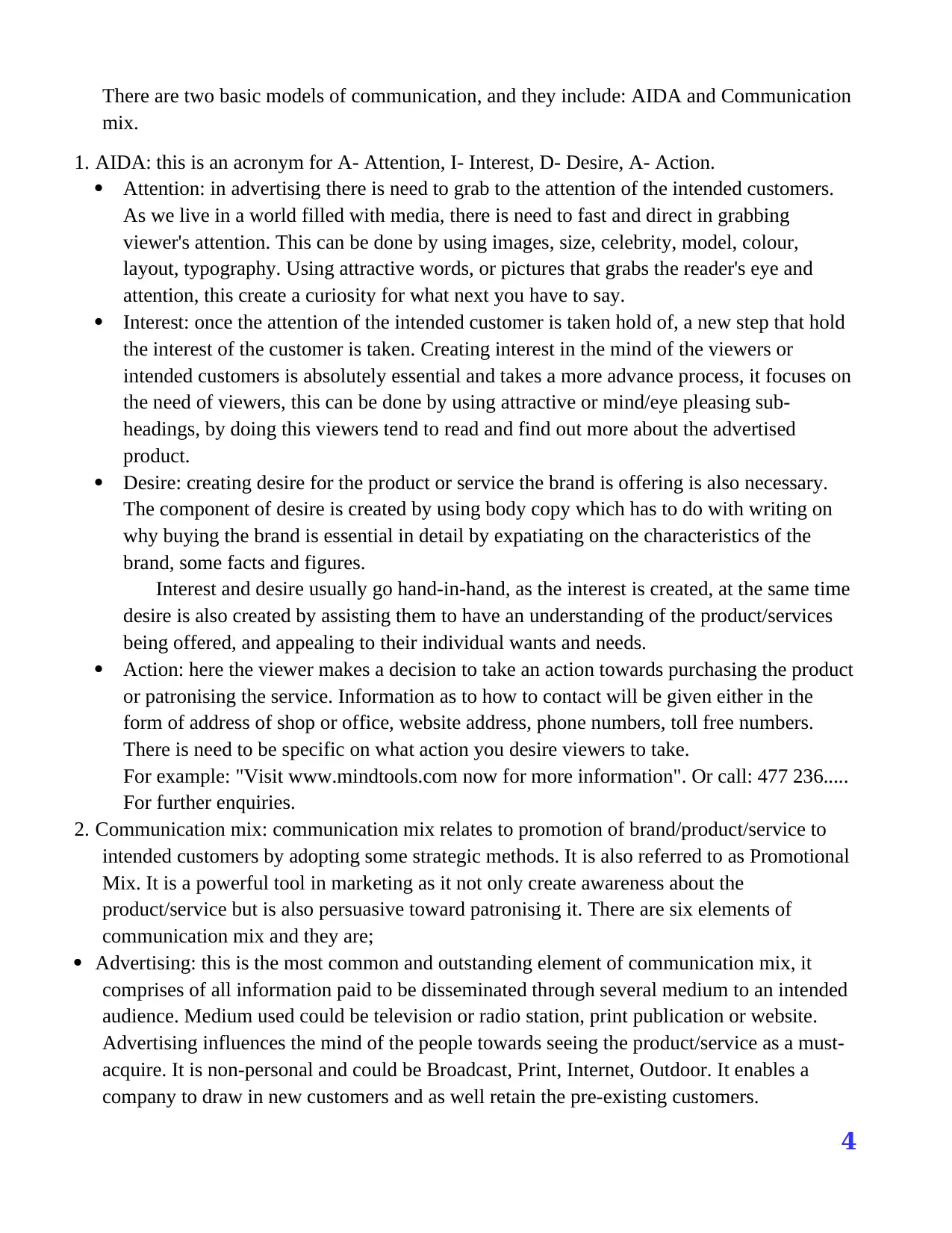
There are two basic models of communication, and they include: AIDA and Communication
mix.
1. AIDA: this is an acronym for A- Attention, I- Interest, D- Desire, A- Action.
Attention: in advertising there is need to grab to the attention of the intended customers.
As we live in a world filled with media, there is need to fast and direct in grabbing
viewer's attention. This can be done by using images, size, celebrity, model, colour,
layout, typography. Using attractive words, or pictures that grabs the reader's eye and
attention, this create a curiosity for what next you have to say.
Interest: once the attention of the intended customer is taken hold of, a new step that hold
the interest of the customer is taken. Creating interest in the mind of the viewers or
intended customers is absolutely essential and takes a more advance process, it focuses on
the need of viewers, this can be done by using attractive or mind/eye pleasing sub-
headings, by doing this viewers tend to read and find out more about the advertised
product.
Desire: creating desire for the product or service the brand is offering is also necessary.
The component of desire is created by using body copy which has to do with writing on
why buying the brand is essential in detail by expatiating on the characteristics of the
brand, some facts and figures.
Interest and desire usually go hand-in-hand, as the interest is created, at the same time
desire is also created by assisting them to have an understanding of the product/services
being offered, and appealing to their individual wants and needs.
Action: here the viewer makes a decision to take an action towards purchasing the product
or patronising the service. Information as to how to contact will be given either in the
form of address of shop or office, website address, phone numbers, toll free numbers.
There is need to be specific on what action you desire viewers to take.
For example: "Visit www.mindtools.com now for more information". Or call: 477 236.....
For further enquiries.
2. Communication mix: communication mix relates to promotion of brand/product/service to
intended customers by adopting some strategic methods. It is also referred to as Promotional
Mix. It is a powerful tool in marketing as it not only create awareness about the
product/service but is also persuasive toward patronising it. There are six elements of
communication mix and they are;
Advertising: this is the most common and outstanding element of communication mix, it
comprises of all information paid to be disseminated through several medium to an intended
audience. Medium used could be television or radio station, print publication or website.
Advertising influences the mind of the people towards seeing the product/service as a must-
acquire. It is non-personal and could be Broadcast, Print, Internet, Outdoor. It enables a
company to draw in new customers and as well retain the pre-existing customers.
4
mix.
1. AIDA: this is an acronym for A- Attention, I- Interest, D- Desire, A- Action.
Attention: in advertising there is need to grab to the attention of the intended customers.
As we live in a world filled with media, there is need to fast and direct in grabbing
viewer's attention. This can be done by using images, size, celebrity, model, colour,
layout, typography. Using attractive words, or pictures that grabs the reader's eye and
attention, this create a curiosity for what next you have to say.
Interest: once the attention of the intended customer is taken hold of, a new step that hold
the interest of the customer is taken. Creating interest in the mind of the viewers or
intended customers is absolutely essential and takes a more advance process, it focuses on
the need of viewers, this can be done by using attractive or mind/eye pleasing sub-
headings, by doing this viewers tend to read and find out more about the advertised
product.
Desire: creating desire for the product or service the brand is offering is also necessary.
The component of desire is created by using body copy which has to do with writing on
why buying the brand is essential in detail by expatiating on the characteristics of the
brand, some facts and figures.
Interest and desire usually go hand-in-hand, as the interest is created, at the same time
desire is also created by assisting them to have an understanding of the product/services
being offered, and appealing to their individual wants and needs.
Action: here the viewer makes a decision to take an action towards purchasing the product
or patronising the service. Information as to how to contact will be given either in the
form of address of shop or office, website address, phone numbers, toll free numbers.
There is need to be specific on what action you desire viewers to take.
For example: "Visit www.mindtools.com now for more information". Or call: 477 236.....
For further enquiries.
2. Communication mix: communication mix relates to promotion of brand/product/service to
intended customers by adopting some strategic methods. It is also referred to as Promotional
Mix. It is a powerful tool in marketing as it not only create awareness about the
product/service but is also persuasive toward patronising it. There are six elements of
communication mix and they are;
Advertising: this is the most common and outstanding element of communication mix, it
comprises of all information paid to be disseminated through several medium to an intended
audience. Medium used could be television or radio station, print publication or website.
Advertising influences the mind of the people towards seeing the product/service as a must-
acquire. It is non-personal and could be Broadcast, Print, Internet, Outdoor. It enables a
company to draw in new customers and as well retain the pre-existing customers.
4
Paraphrase This Document
Need a fresh take? Get an instant paraphrase of this document with our AI Paraphraser
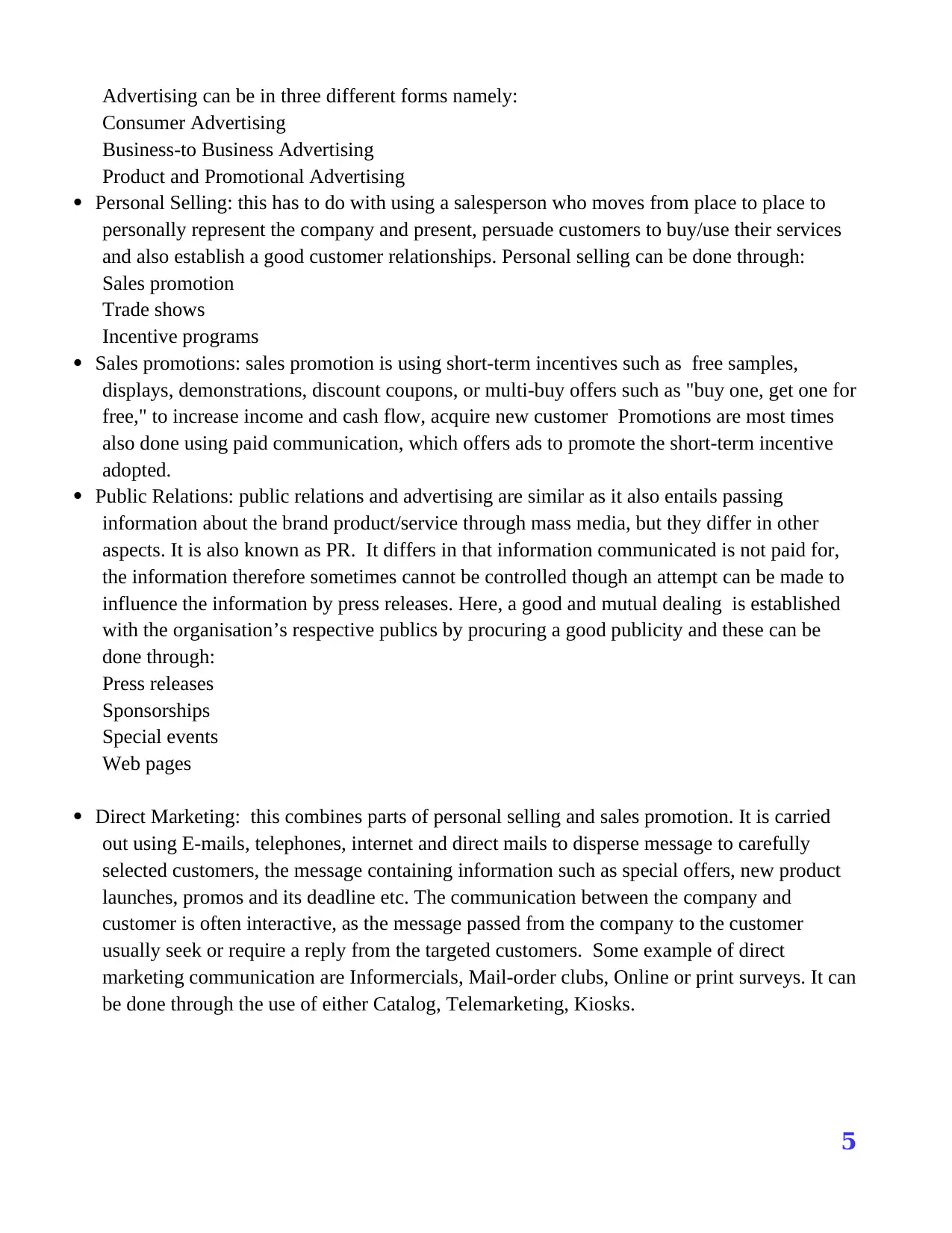
Advertising can be in three different forms namely:
Consumer Advertising
Business-to Business Advertising
Product and Promotional Advertising
Personal Selling: this has to do with using a salesperson who moves from place to place to
personally represent the company and present, persuade customers to buy/use their services
and also establish a good customer relationships. Personal selling can be done through:
Sales promotion
Trade shows
Incentive programs
Sales promotions: sales promotion is using short-term incentives such as free samples,
displays, demonstrations, discount coupons, or multi-buy offers such as "buy one, get one for
free," to increase income and cash flow, acquire new customer Promotions are most times
also done using paid communication, which offers ads to promote the short-term incentive
adopted.
Public Relations: public relations and advertising are similar as it also entails passing
information about the brand product/service through mass media, but they differ in other
aspects. It is also known as PR. It differs in that information communicated is not paid for,
the information therefore sometimes cannot be controlled though an attempt can be made to
influence the information by press releases. Here, a good and mutual dealing is established
with the organisation’s respective publics by procuring a good publicity and these can be
done through:
Press releases
Sponsorships
Special events
Web pages
Direct Marketing: this combines parts of personal selling and sales promotion. It is carried
out using E-mails, telephones, internet and direct mails to disperse message to carefully
selected customers, the message containing information such as special offers, new product
launches, promos and its deadline etc. The communication between the company and
customer is often interactive, as the message passed from the company to the customer
usually seek or require a reply from the targeted customers. Some example of direct
marketing communication are Informercials, Mail-order clubs, Online or print surveys. It can
be done through the use of either Catalog, Telemarketing, Kiosks.
5
Consumer Advertising
Business-to Business Advertising
Product and Promotional Advertising
Personal Selling: this has to do with using a salesperson who moves from place to place to
personally represent the company and present, persuade customers to buy/use their services
and also establish a good customer relationships. Personal selling can be done through:
Sales promotion
Trade shows
Incentive programs
Sales promotions: sales promotion is using short-term incentives such as free samples,
displays, demonstrations, discount coupons, or multi-buy offers such as "buy one, get one for
free," to increase income and cash flow, acquire new customer Promotions are most times
also done using paid communication, which offers ads to promote the short-term incentive
adopted.
Public Relations: public relations and advertising are similar as it also entails passing
information about the brand product/service through mass media, but they differ in other
aspects. It is also known as PR. It differs in that information communicated is not paid for,
the information therefore sometimes cannot be controlled though an attempt can be made to
influence the information by press releases. Here, a good and mutual dealing is established
with the organisation’s respective publics by procuring a good publicity and these can be
done through:
Press releases
Sponsorships
Special events
Web pages
Direct Marketing: this combines parts of personal selling and sales promotion. It is carried
out using E-mails, telephones, internet and direct mails to disperse message to carefully
selected customers, the message containing information such as special offers, new product
launches, promos and its deadline etc. The communication between the company and
customer is often interactive, as the message passed from the company to the customer
usually seek or require a reply from the targeted customers. Some example of direct
marketing communication are Informercials, Mail-order clubs, Online or print surveys. It can
be done through the use of either Catalog, Telemarketing, Kiosks.
5
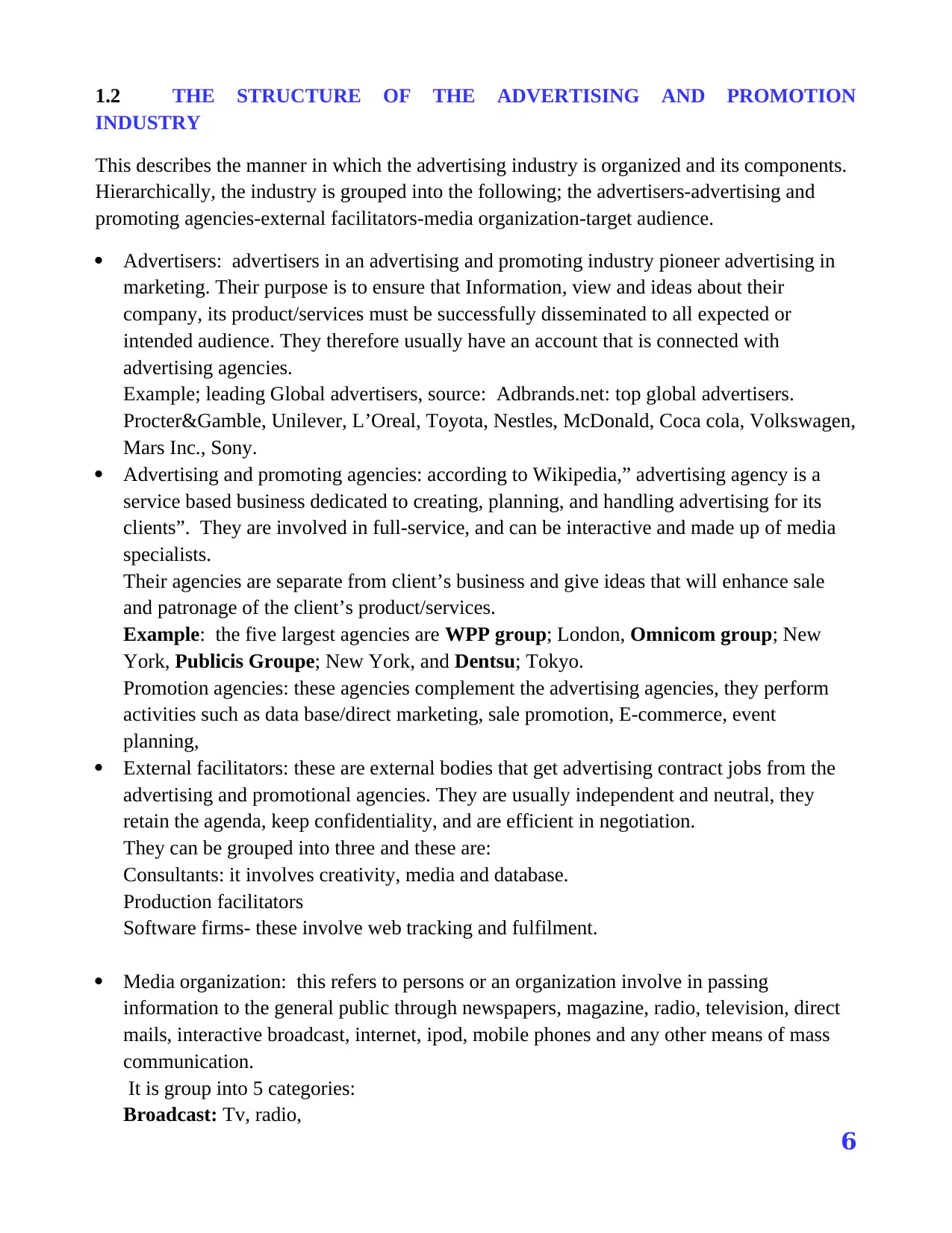
1.2 THE STRUCTURE OF THE ADVERTISING AND PROMOTION
INDUSTRY
This describes the manner in which the advertising industry is organized and its components.
Hierarchically, the industry is grouped into the following; the advertisers-advertising and
promoting agencies-external facilitators-media organization-target audience.
Advertisers: advertisers in an advertising and promoting industry pioneer advertising in
marketing. Their purpose is to ensure that Information, view and ideas about their
company, its product/services must be successfully disseminated to all expected or
intended audience. They therefore usually have an account that is connected with
advertising agencies.
Example; leading Global advertisers, source: Adbrands.net: top global advertisers.
Procter&Gamble, Unilever, L’Oreal, Toyota, Nestles, McDonald, Coca cola, Volkswagen,
Mars Inc., Sony.
Advertising and promoting agencies: according to Wikipedia,” advertising agency is a
service based business dedicated to creating, planning, and handling advertising for its
clients”. They are involved in full-service, and can be interactive and made up of media
specialists.
Their agencies are separate from client’s business and give ideas that will enhance sale
and patronage of the client’s product/services.
Example: the five largest agencies are WPP group; London, Omnicom group; New
York, Publicis Groupe; New York, and Dentsu; Tokyo.
Promotion agencies: these agencies complement the advertising agencies, they perform
activities such as data base/direct marketing, sale promotion, E-commerce, event
planning,
External facilitators: these are external bodies that get advertising contract jobs from the
advertising and promotional agencies. They are usually independent and neutral, they
retain the agenda, keep confidentiality, and are efficient in negotiation.
They can be grouped into three and these are:
Consultants: it involves creativity, media and database.
Production facilitators
Software firms- these involve web tracking and fulfilment.
Media organization: this refers to persons or an organization involve in passing
information to the general public through newspapers, magazine, radio, television, direct
mails, interactive broadcast, internet, ipod, mobile phones and any other means of mass
communication.
It is group into 5 categories:
Broadcast: Tv, radio,
6
INDUSTRY
This describes the manner in which the advertising industry is organized and its components.
Hierarchically, the industry is grouped into the following; the advertisers-advertising and
promoting agencies-external facilitators-media organization-target audience.
Advertisers: advertisers in an advertising and promoting industry pioneer advertising in
marketing. Their purpose is to ensure that Information, view and ideas about their
company, its product/services must be successfully disseminated to all expected or
intended audience. They therefore usually have an account that is connected with
advertising agencies.
Example; leading Global advertisers, source: Adbrands.net: top global advertisers.
Procter&Gamble, Unilever, L’Oreal, Toyota, Nestles, McDonald, Coca cola, Volkswagen,
Mars Inc., Sony.
Advertising and promoting agencies: according to Wikipedia,” advertising agency is a
service based business dedicated to creating, planning, and handling advertising for its
clients”. They are involved in full-service, and can be interactive and made up of media
specialists.
Their agencies are separate from client’s business and give ideas that will enhance sale
and patronage of the client’s product/services.
Example: the five largest agencies are WPP group; London, Omnicom group; New
York, Publicis Groupe; New York, and Dentsu; Tokyo.
Promotion agencies: these agencies complement the advertising agencies, they perform
activities such as data base/direct marketing, sale promotion, E-commerce, event
planning,
External facilitators: these are external bodies that get advertising contract jobs from the
advertising and promotional agencies. They are usually independent and neutral, they
retain the agenda, keep confidentiality, and are efficient in negotiation.
They can be grouped into three and these are:
Consultants: it involves creativity, media and database.
Production facilitators
Software firms- these involve web tracking and fulfilment.
Media organization: this refers to persons or an organization involve in passing
information to the general public through newspapers, magazine, radio, television, direct
mails, interactive broadcast, internet, ipod, mobile phones and any other means of mass
communication.
It is group into 5 categories:
Broadcast: Tv, radio,
6
⊘ This is a preview!⊘
Do you want full access?
Subscribe today to unlock all pages.

Trusted by 1+ million students worldwide
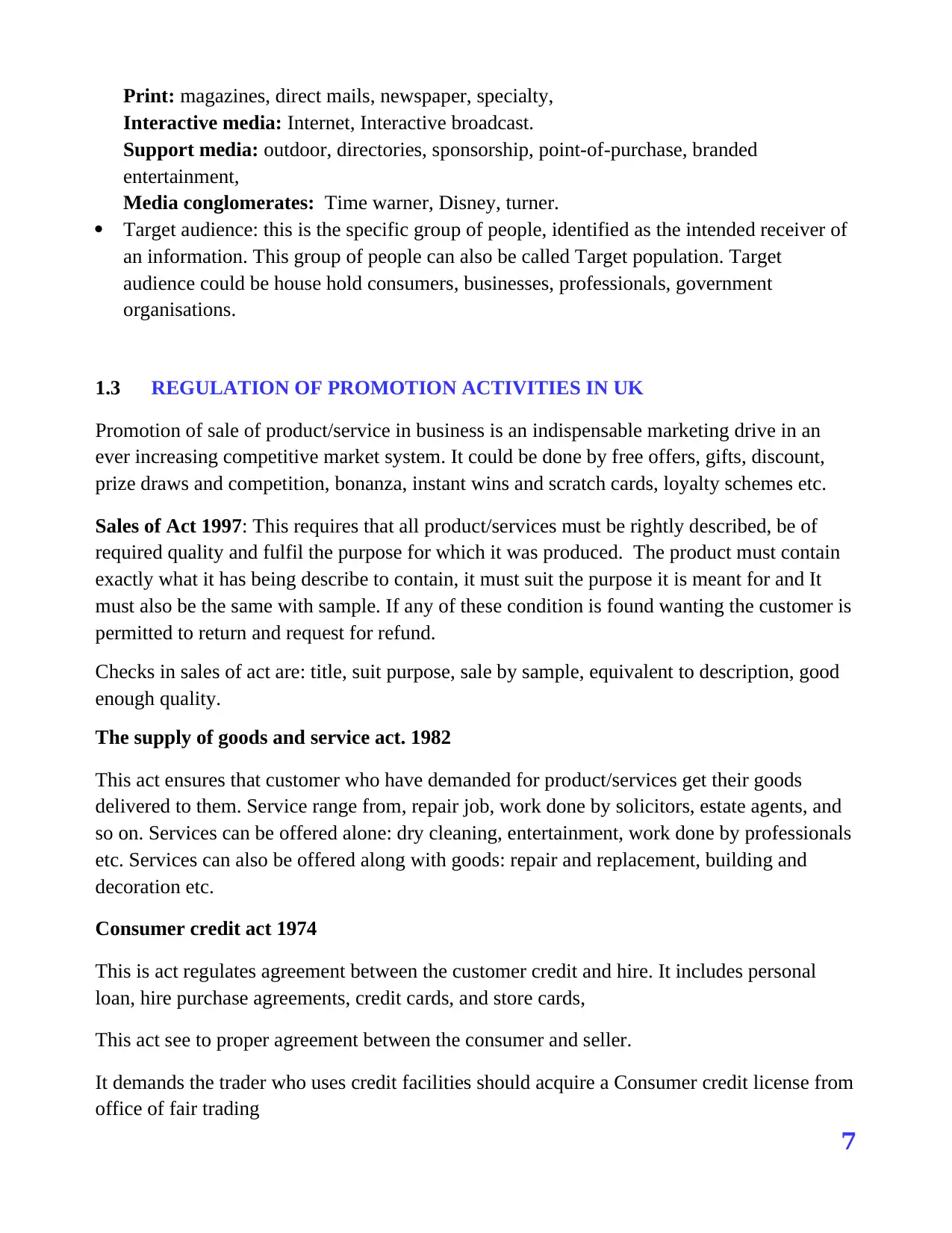
Print: magazines, direct mails, newspaper, specialty,
Interactive media: Internet, Interactive broadcast.
Support media: outdoor, directories, sponsorship, point-of-purchase, branded
entertainment,
Media conglomerates: Time warner, Disney, turner.
Target audience: this is the specific group of people, identified as the intended receiver of
an information. This group of people can also be called Target population. Target
audience could be house hold consumers, businesses, professionals, government
organisations.
1.3 REGULATION OF PROMOTION ACTIVITIES IN UK
Promotion of sale of product/service in business is an indispensable marketing drive in an
ever increasing competitive market system. It could be done by free offers, gifts, discount,
prize draws and competition, bonanza, instant wins and scratch cards, loyalty schemes etc.
Sales of Act 1997: This requires that all product/services must be rightly described, be of
required quality and fulfil the purpose for which it was produced. The product must contain
exactly what it has being describe to contain, it must suit the purpose it is meant for and It
must also be the same with sample. If any of these condition is found wanting the customer is
permitted to return and request for refund.
Checks in sales of act are: title, suit purpose, sale by sample, equivalent to description, good
enough quality.
The supply of goods and service act. 1982
This act ensures that customer who have demanded for product/services get their goods
delivered to them. Service range from, repair job, work done by solicitors, estate agents, and
so on. Services can be offered alone: dry cleaning, entertainment, work done by professionals
etc. Services can also be offered along with goods: repair and replacement, building and
decoration etc.
Consumer credit act 1974
This is act regulates agreement between the customer credit and hire. It includes personal
loan, hire purchase agreements, credit cards, and store cards,
This act see to proper agreement between the consumer and seller.
It demands the trader who uses credit facilities should acquire a Consumer credit license from
office of fair trading
7
Interactive media: Internet, Interactive broadcast.
Support media: outdoor, directories, sponsorship, point-of-purchase, branded
entertainment,
Media conglomerates: Time warner, Disney, turner.
Target audience: this is the specific group of people, identified as the intended receiver of
an information. This group of people can also be called Target population. Target
audience could be house hold consumers, businesses, professionals, government
organisations.
1.3 REGULATION OF PROMOTION ACTIVITIES IN UK
Promotion of sale of product/service in business is an indispensable marketing drive in an
ever increasing competitive market system. It could be done by free offers, gifts, discount,
prize draws and competition, bonanza, instant wins and scratch cards, loyalty schemes etc.
Sales of Act 1997: This requires that all product/services must be rightly described, be of
required quality and fulfil the purpose for which it was produced. The product must contain
exactly what it has being describe to contain, it must suit the purpose it is meant for and It
must also be the same with sample. If any of these condition is found wanting the customer is
permitted to return and request for refund.
Checks in sales of act are: title, suit purpose, sale by sample, equivalent to description, good
enough quality.
The supply of goods and service act. 1982
This act ensures that customer who have demanded for product/services get their goods
delivered to them. Service range from, repair job, work done by solicitors, estate agents, and
so on. Services can be offered alone: dry cleaning, entertainment, work done by professionals
etc. Services can also be offered along with goods: repair and replacement, building and
decoration etc.
Consumer credit act 1974
This is act regulates agreement between the customer credit and hire. It includes personal
loan, hire purchase agreements, credit cards, and store cards,
This act see to proper agreement between the consumer and seller.
It demands the trader who uses credit facilities should acquire a Consumer credit license from
office of fair trading
7
Paraphrase This Document
Need a fresh take? Get an instant paraphrase of this document with our AI Paraphraser

It also lays down guide to be applied where agreement is settled early or agreement is
defaulted, or ended.
The data protecting act 1998/2008.
This act controls how organisation, businesses, government use individuals' personal
information. It ensures that these information must be used:
Lawfully and unbiased
For a specified time and purpose
Moderately, rightly, with relevance
Must not be reassigned beyond European Economic area until it is well protected.
Must be kept safe and well secured.
Distance selling regulation 2000 Act: this act is no longer utilized in the UK, it is utilized on
all distance buying and selling which usually includes online shopping, mail order, phone
order or shopping through some TV channels.
Sellers in these forums must give information such as; proper description of product/service,
the price of the product/service, date and mode of delivery, cancellation right if there is,
details about the seller.
Regulation of promotion stipulate rules that will guide any form of promotion by any
company in the UK;
The UK self-regulatory system: Self-regulation plays an important and complementary role
to the legal provisions which governs advertising and marketing communication, and any
examination of the regulation of sales promotion in the UK must give due consideration to
the self-regulatory system. (Hill smith, 2003).
The regulation of promotion in UK is done through some acts like the customer protection
from unfair trading regulations. UK regulatory bodies includes;
Office of communication (Ofcom): this body regulates communication in the UK. It is run
under some Acts of parliament most importantly the Communication Act 2003.
Their major duty is to regulate TV, radio, and video on demand sectors, fixed line
telecoms, mobiles, postal services, plus the airwaves over which wireless devices operates
by:
Advertising standards authority (ASA): is a non-governmental organization and a self-
regulatory organization in the UK.
8
defaulted, or ended.
The data protecting act 1998/2008.
This act controls how organisation, businesses, government use individuals' personal
information. It ensures that these information must be used:
Lawfully and unbiased
For a specified time and purpose
Moderately, rightly, with relevance
Must not be reassigned beyond European Economic area until it is well protected.
Must be kept safe and well secured.
Distance selling regulation 2000 Act: this act is no longer utilized in the UK, it is utilized on
all distance buying and selling which usually includes online shopping, mail order, phone
order or shopping through some TV channels.
Sellers in these forums must give information such as; proper description of product/service,
the price of the product/service, date and mode of delivery, cancellation right if there is,
details about the seller.
Regulation of promotion stipulate rules that will guide any form of promotion by any
company in the UK;
The UK self-regulatory system: Self-regulation plays an important and complementary role
to the legal provisions which governs advertising and marketing communication, and any
examination of the regulation of sales promotion in the UK must give due consideration to
the self-regulatory system. (Hill smith, 2003).
The regulation of promotion in UK is done through some acts like the customer protection
from unfair trading regulations. UK regulatory bodies includes;
Office of communication (Ofcom): this body regulates communication in the UK. It is run
under some Acts of parliament most importantly the Communication Act 2003.
Their major duty is to regulate TV, radio, and video on demand sectors, fixed line
telecoms, mobiles, postal services, plus the airwaves over which wireless devices operates
by:
Advertising standards authority (ASA): is a non-governmental organization and a self-
regulatory organization in the UK.
8

Their role is to regulate the of advertisements, sales promotions and direct marketing in
the UK by investigating complaints made about ads, sales, promotions or direct
marketing and deciding whether such advertising complies with its advertising standards
codes. (About and short guide. www.asa.org.uk)
These codes stipulate that “before distributing or submitting a marketing communication
for publication, marketers, must hold documentary evidence to prove all claims, whether
direct or implied , that are capable of objective substantiation” and that “no marketing
communication should mislead, by inaccuracy, ambiguity, exaggeration, omission or
otherwise”. (asa codes, www.asa.org.uk)
Broadcast committees of advertising practice (BCAP): This regulatory body which is
established by the Communications Act 2003, ensures abidance with laid down standard
practise in UK. It is responsible for writing and re-examination of code of broadcast
advertising in UK.
Committees of advertising practice (CAP): This always work along with BCAP, they
write and assists in implementing advertising codes also give advice and training of
personnel in the media industry.
1.4 THE CURRENT TREND IN ADVERTISING AND PROMOTION INCLUDING
IMPACT OF ICT
Advertising trends have developed from traditional print ads, TV spots to new marketing
schemes which include More. User-Generated content, advancement in social advertising,
Make-or-Break Native advertising, Mobile device optimisation, focus on content marketing,
Micro targeting, wearing technology, In-store Mobile campaigns, increase in video
production. These new marketing schemes are developed on basis of new technology that is
fast evolving, they therefore create new and fast approach to reach out targeted customers.
Information and communication technology, in advertising helps to create audience
awareness using internet, television, and mobile phone thereby acquiring advancement over
non ICT advertising and promotional materials.
More User-generated content- Acronym for this is UGC. It signifies content of any
form which includes blogs, tweets, podcasts, chats, posts, wikis, digital images and
every other kind of media which were formed by users of an internet system. It is
most appreciated for its consumer-prize authenticity, opportunity given to consumer to
have some control. It entails creativity, genuineness, view, passing along a profoundly
personal feeling that is impossible for a brand to create anew. UGC is frequently
made accessible and ready for use via the social media. It allows for conversation
between the customer and the brand and also gives new avenues for engagement by
encouraging consumers to share something about them with the brand, who
9
the UK by investigating complaints made about ads, sales, promotions or direct
marketing and deciding whether such advertising complies with its advertising standards
codes. (About and short guide. www.asa.org.uk)
These codes stipulate that “before distributing or submitting a marketing communication
for publication, marketers, must hold documentary evidence to prove all claims, whether
direct or implied , that are capable of objective substantiation” and that “no marketing
communication should mislead, by inaccuracy, ambiguity, exaggeration, omission or
otherwise”. (asa codes, www.asa.org.uk)
Broadcast committees of advertising practice (BCAP): This regulatory body which is
established by the Communications Act 2003, ensures abidance with laid down standard
practise in UK. It is responsible for writing and re-examination of code of broadcast
advertising in UK.
Committees of advertising practice (CAP): This always work along with BCAP, they
write and assists in implementing advertising codes also give advice and training of
personnel in the media industry.
1.4 THE CURRENT TREND IN ADVERTISING AND PROMOTION INCLUDING
IMPACT OF ICT
Advertising trends have developed from traditional print ads, TV spots to new marketing
schemes which include More. User-Generated content, advancement in social advertising,
Make-or-Break Native advertising, Mobile device optimisation, focus on content marketing,
Micro targeting, wearing technology, In-store Mobile campaigns, increase in video
production. These new marketing schemes are developed on basis of new technology that is
fast evolving, they therefore create new and fast approach to reach out targeted customers.
Information and communication technology, in advertising helps to create audience
awareness using internet, television, and mobile phone thereby acquiring advancement over
non ICT advertising and promotional materials.
More User-generated content- Acronym for this is UGC. It signifies content of any
form which includes blogs, tweets, podcasts, chats, posts, wikis, digital images and
every other kind of media which were formed by users of an internet system. It is
most appreciated for its consumer-prize authenticity, opportunity given to consumer to
have some control. It entails creativity, genuineness, view, passing along a profoundly
personal feeling that is impossible for a brand to create anew. UGC is frequently
made accessible and ready for use via the social media. It allows for conversation
between the customer and the brand and also gives new avenues for engagement by
encouraging consumers to share something about them with the brand, who
9
⊘ This is a preview!⊘
Do you want full access?
Subscribe today to unlock all pages.

Trusted by 1+ million students worldwide
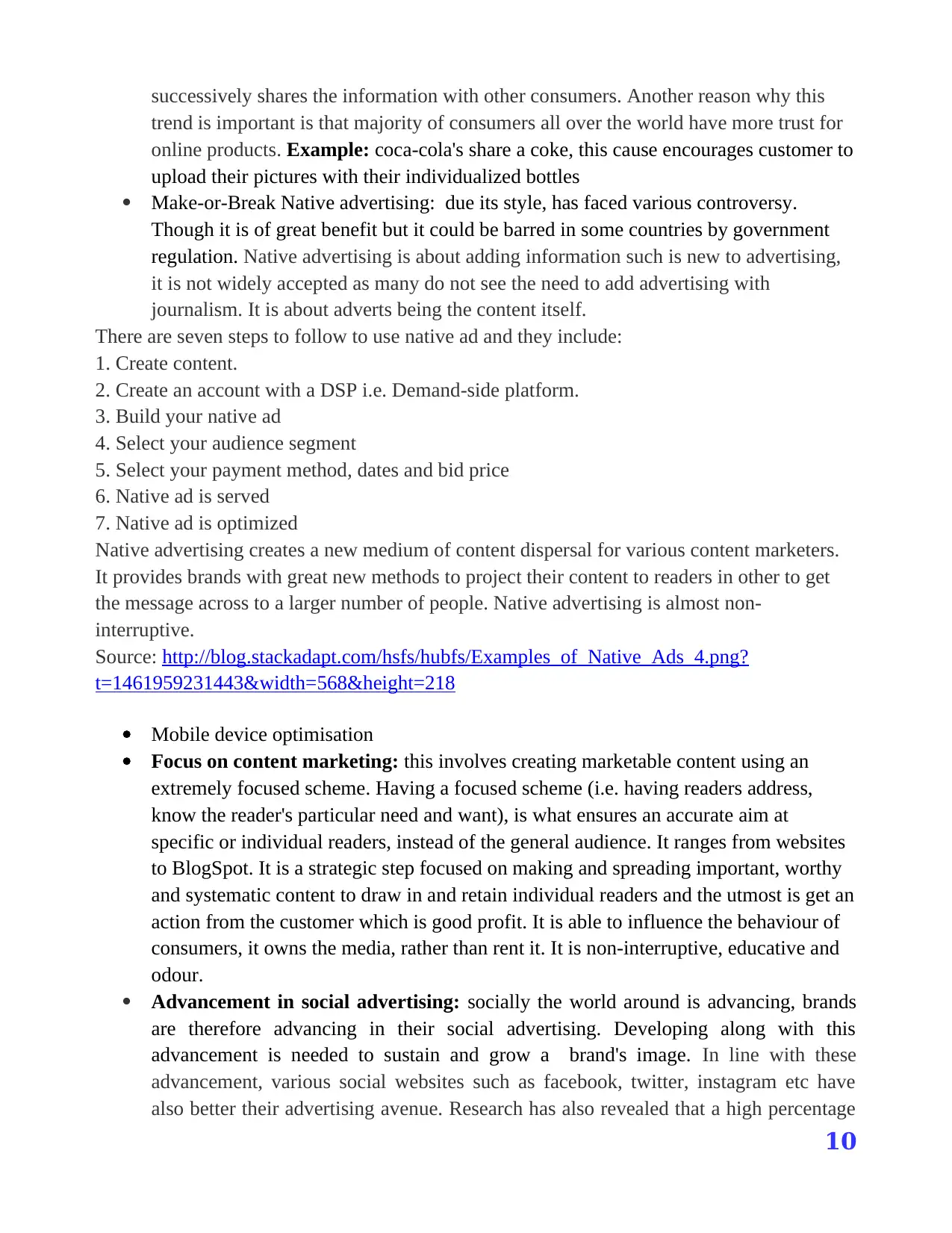
successively shares the information with other consumers. Another reason why this
trend is important is that majority of consumers all over the world have more trust for
online products. Example: coca-cola's share a coke, this cause encourages customer to
upload their pictures with their individualized bottles
Make-or-Break Native advertising: due its style, has faced various controversy.
Though it is of great benefit but it could be barred in some countries by government
regulation. Native advertising is about adding information such is new to advertising,
it is not widely accepted as many do not see the need to add advertising with
journalism. It is about adverts being the content itself.
There are seven steps to follow to use native ad and they include:
1. Create content.
2. Create an account with a DSP i.e. Demand-side platform.
3. Build your native ad
4. Select your audience segment
5. Select your payment method, dates and bid price
6. Native ad is served
7. Native ad is optimized
Native advertising creates a new medium of content dispersal for various content marketers.
It provides brands with great new methods to project their content to readers in other to get
the message across to a larger number of people. Native advertising is almost non-
interruptive.
Source: http://blog.stackadapt.com/hsfs/hubfs/Examples_of_Native_Ads_4.png?
t=1461959231443&width=568&height=218
Mobile device optimisation
Focus on content marketing: this involves creating marketable content using an
extremely focused scheme. Having a focused scheme (i.e. having readers address,
know the reader's particular need and want), is what ensures an accurate aim at
specific or individual readers, instead of the general audience. It ranges from websites
to BlogSpot. It is a strategic step focused on making and spreading important, worthy
and systematic content to draw in and retain individual readers and the utmost is get an
action from the customer which is good profit. It is able to influence the behaviour of
consumers, it owns the media, rather than rent it. It is non-interruptive, educative and
odour.
Advancement in social advertising: socially the world around is advancing, brands
are therefore advancing in their social advertising. Developing along with this
advancement is needed to sustain and grow a brand's image. In line with these
advancement, various social websites such as facebook, twitter, instagram etc have
also better their advertising avenue. Research has also revealed that a high percentage
10
trend is important is that majority of consumers all over the world have more trust for
online products. Example: coca-cola's share a coke, this cause encourages customer to
upload their pictures with their individualized bottles
Make-or-Break Native advertising: due its style, has faced various controversy.
Though it is of great benefit but it could be barred in some countries by government
regulation. Native advertising is about adding information such is new to advertising,
it is not widely accepted as many do not see the need to add advertising with
journalism. It is about adverts being the content itself.
There are seven steps to follow to use native ad and they include:
1. Create content.
2. Create an account with a DSP i.e. Demand-side platform.
3. Build your native ad
4. Select your audience segment
5. Select your payment method, dates and bid price
6. Native ad is served
7. Native ad is optimized
Native advertising creates a new medium of content dispersal for various content marketers.
It provides brands with great new methods to project their content to readers in other to get
the message across to a larger number of people. Native advertising is almost non-
interruptive.
Source: http://blog.stackadapt.com/hsfs/hubfs/Examples_of_Native_Ads_4.png?
t=1461959231443&width=568&height=218
Mobile device optimisation
Focus on content marketing: this involves creating marketable content using an
extremely focused scheme. Having a focused scheme (i.e. having readers address,
know the reader's particular need and want), is what ensures an accurate aim at
specific or individual readers, instead of the general audience. It ranges from websites
to BlogSpot. It is a strategic step focused on making and spreading important, worthy
and systematic content to draw in and retain individual readers and the utmost is get an
action from the customer which is good profit. It is able to influence the behaviour of
consumers, it owns the media, rather than rent it. It is non-interruptive, educative and
odour.
Advancement in social advertising: socially the world around is advancing, brands
are therefore advancing in their social advertising. Developing along with this
advancement is needed to sustain and grow a brand's image. In line with these
advancement, various social websites such as facebook, twitter, instagram etc have
also better their advertising avenue. Research has also revealed that a high percentage
10
Paraphrase This Document
Need a fresh take? Get an instant paraphrase of this document with our AI Paraphraser
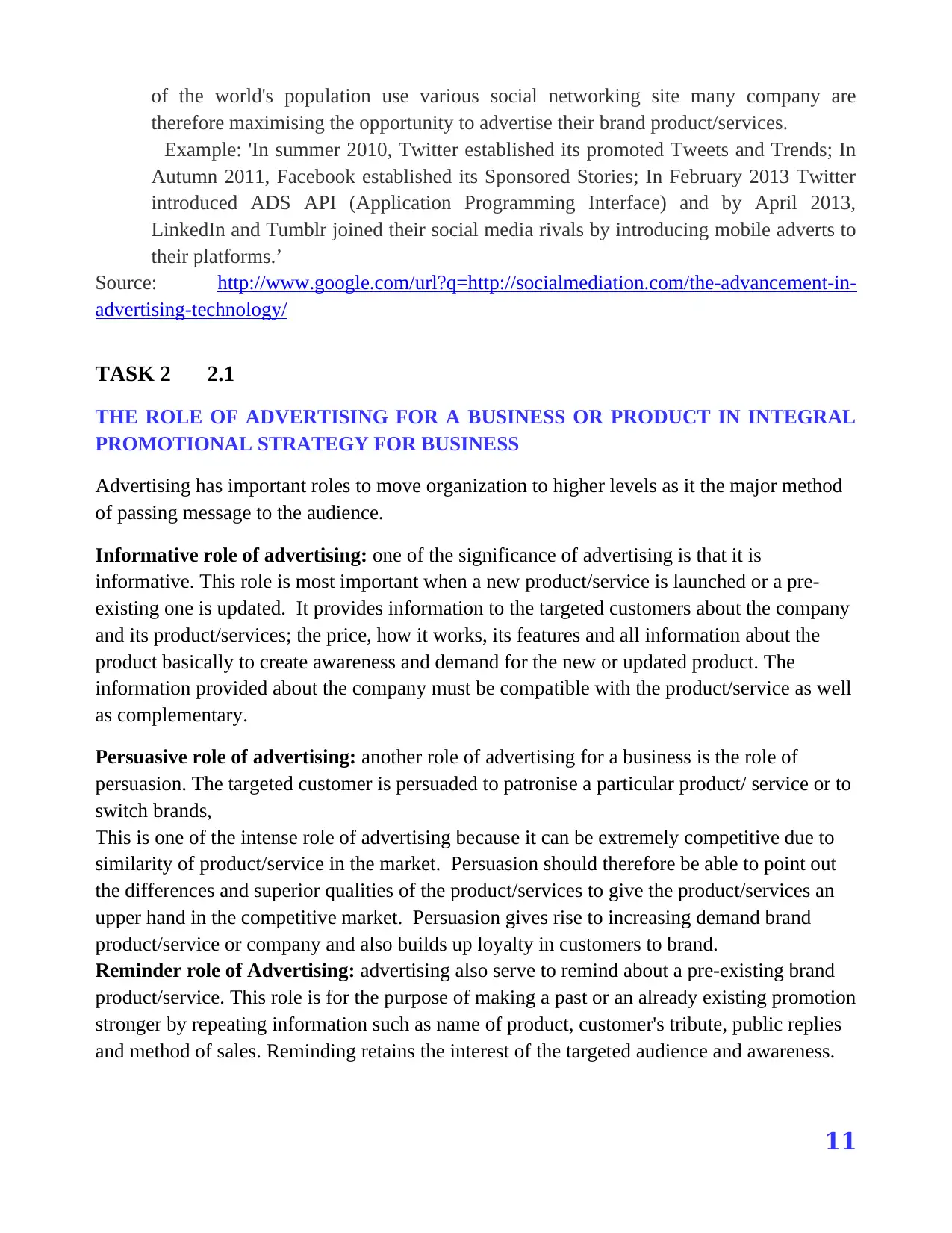
of the world's population use various social networking site many company are
therefore maximising the opportunity to advertise their brand product/services.
Example: 'In summer 2010, Twitter established its promoted Tweets and Trends; In
Autumn 2011, Facebook established its Sponsored Stories; In February 2013 Twitter
introduced ADS API (Application Programming Interface) and by April 2013,
LinkedIn and Tumblr joined their social media rivals by introducing mobile adverts to
their platforms.’
Source: http://www.google.com/url?q=http://socialmediation.com/the-advancement-in-
advertising-technology/
TASK 2 2.1
THE ROLE OF ADVERTISING FOR A BUSINESS OR PRODUCT IN INTEGRAL
PROMOTIONAL STRATEGY FOR BUSINESS
Advertising has important roles to move organization to higher levels as it the major method
of passing message to the audience.
Informative role of advertising: one of the significance of advertising is that it is
informative. This role is most important when a new product/service is launched or a pre-
existing one is updated. It provides information to the targeted customers about the company
and its product/services; the price, how it works, its features and all information about the
product basically to create awareness and demand for the new or updated product. The
information provided about the company must be compatible with the product/service as well
as complementary.
Persuasive role of advertising: another role of advertising for a business is the role of
persuasion. The targeted customer is persuaded to patronise a particular product/ service or to
switch brands,
This is one of the intense role of advertising because it can be extremely competitive due to
similarity of product/service in the market. Persuasion should therefore be able to point out
the differences and superior qualities of the product/services to give the product/services an
upper hand in the competitive market. Persuasion gives rise to increasing demand brand
product/service or company and also builds up loyalty in customers to brand.
Reminder role of Advertising: advertising also serve to remind about a pre-existing brand
product/service. This role is for the purpose of making a past or an already existing promotion
stronger by repeating information such as name of product, customer's tribute, public replies
and method of sales. Reminding retains the interest of the targeted audience and awareness.
11
therefore maximising the opportunity to advertise their brand product/services.
Example: 'In summer 2010, Twitter established its promoted Tweets and Trends; In
Autumn 2011, Facebook established its Sponsored Stories; In February 2013 Twitter
introduced ADS API (Application Programming Interface) and by April 2013,
LinkedIn and Tumblr joined their social media rivals by introducing mobile adverts to
their platforms.’
Source: http://www.google.com/url?q=http://socialmediation.com/the-advancement-in-
advertising-technology/
TASK 2 2.1
THE ROLE OF ADVERTISING FOR A BUSINESS OR PRODUCT IN INTEGRAL
PROMOTIONAL STRATEGY FOR BUSINESS
Advertising has important roles to move organization to higher levels as it the major method
of passing message to the audience.
Informative role of advertising: one of the significance of advertising is that it is
informative. This role is most important when a new product/service is launched or a pre-
existing one is updated. It provides information to the targeted customers about the company
and its product/services; the price, how it works, its features and all information about the
product basically to create awareness and demand for the new or updated product. The
information provided about the company must be compatible with the product/service as well
as complementary.
Persuasive role of advertising: another role of advertising for a business is the role of
persuasion. The targeted customer is persuaded to patronise a particular product/ service or to
switch brands,
This is one of the intense role of advertising because it can be extremely competitive due to
similarity of product/service in the market. Persuasion should therefore be able to point out
the differences and superior qualities of the product/services to give the product/services an
upper hand in the competitive market. Persuasion gives rise to increasing demand brand
product/service or company and also builds up loyalty in customers to brand.
Reminder role of Advertising: advertising also serve to remind about a pre-existing brand
product/service. This role is for the purpose of making a past or an already existing promotion
stronger by repeating information such as name of product, customer's tribute, public replies
and method of sales. Reminding retains the interest of the targeted audience and awareness.
11
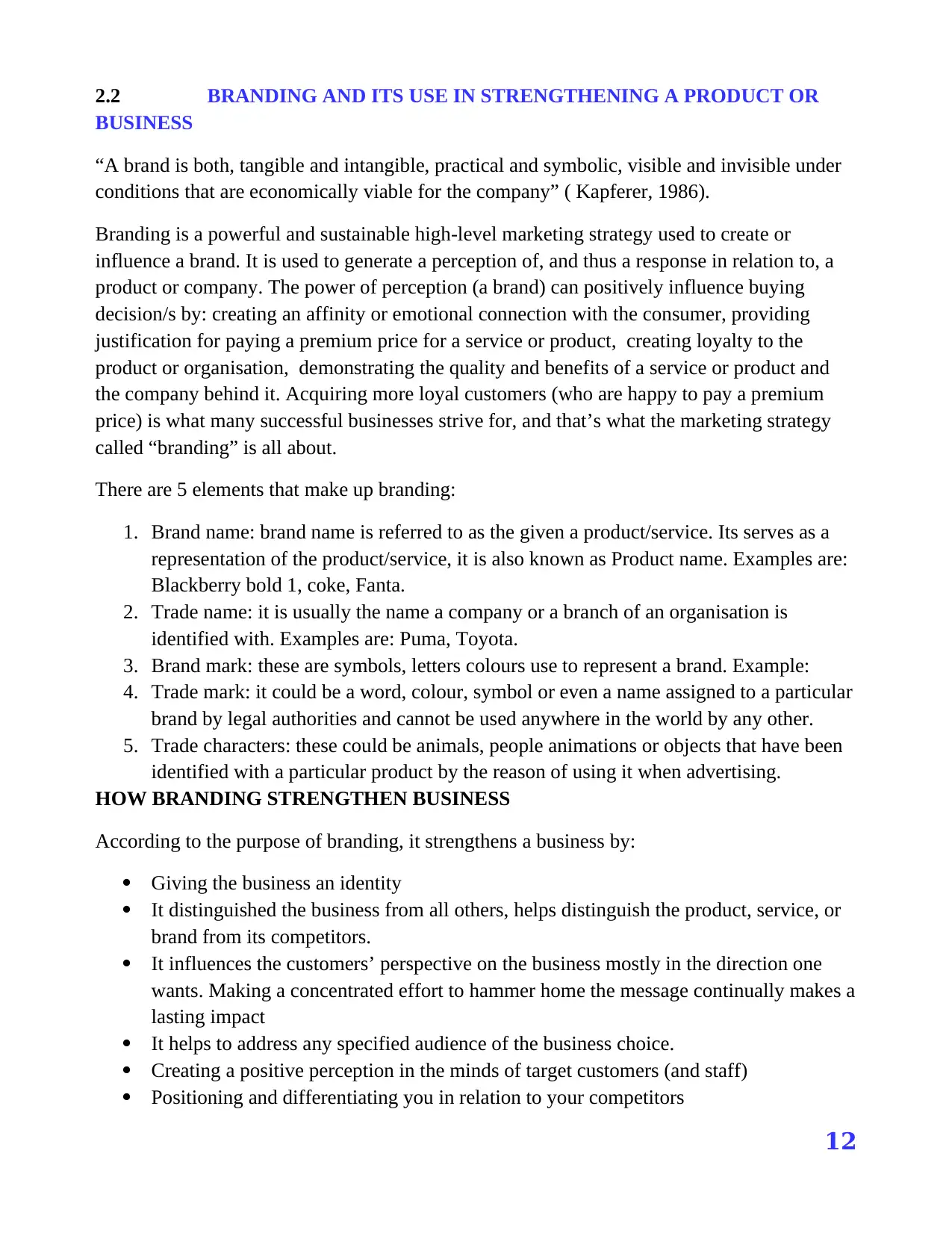
2.2 BRANDING AND ITS USE IN STRENGTHENING A PRODUCT OR
BUSINESS
“A brand is both, tangible and intangible, practical and symbolic, visible and invisible under
conditions that are economically viable for the company” ( Kapferer, 1986).
Branding is a powerful and sustainable high-level marketing strategy used to create or
influence a brand. It is used to generate a perception of, and thus a response in relation to, a
product or company. The power of perception (a brand) can positively influence buying
decision/s by: creating an affinity or emotional connection with the consumer, providing
justification for paying a premium price for a service or product, creating loyalty to the
product or organisation, demonstrating the quality and benefits of a service or product and
the company behind it. Acquiring more loyal customers (who are happy to pay a premium
price) is what many successful businesses strive for, and that’s what the marketing strategy
called “branding” is all about.
There are 5 elements that make up branding:
1. Brand name: brand name is referred to as the given a product/service. Its serves as a
representation of the product/service, it is also known as Product name. Examples are:
Blackberry bold 1, coke, Fanta.
2. Trade name: it is usually the name a company or a branch of an organisation is
identified with. Examples are: Puma, Toyota.
3. Brand mark: these are symbols, letters colours use to represent a brand. Example:
4. Trade mark: it could be a word, colour, symbol or even a name assigned to a particular
brand by legal authorities and cannot be used anywhere in the world by any other.
5. Trade characters: these could be animals, people animations or objects that have been
identified with a particular product by the reason of using it when advertising.
HOW BRANDING STRENGTHEN BUSINESS
According to the purpose of branding, it strengthens a business by:
Giving the business an identity
It distinguished the business from all others, helps distinguish the product, service, or
brand from its competitors.
It influences the customers’ perspective on the business mostly in the direction one
wants. Making a concentrated effort to hammer home the message continually makes a
lasting impact
It helps to address any specified audience of the business choice.
Creating a positive perception in the minds of target customers (and staff)
Positioning and differentiating you in relation to your competitors
12
BUSINESS
“A brand is both, tangible and intangible, practical and symbolic, visible and invisible under
conditions that are economically viable for the company” ( Kapferer, 1986).
Branding is a powerful and sustainable high-level marketing strategy used to create or
influence a brand. It is used to generate a perception of, and thus a response in relation to, a
product or company. The power of perception (a brand) can positively influence buying
decision/s by: creating an affinity or emotional connection with the consumer, providing
justification for paying a premium price for a service or product, creating loyalty to the
product or organisation, demonstrating the quality and benefits of a service or product and
the company behind it. Acquiring more loyal customers (who are happy to pay a premium
price) is what many successful businesses strive for, and that’s what the marketing strategy
called “branding” is all about.
There are 5 elements that make up branding:
1. Brand name: brand name is referred to as the given a product/service. Its serves as a
representation of the product/service, it is also known as Product name. Examples are:
Blackberry bold 1, coke, Fanta.
2. Trade name: it is usually the name a company or a branch of an organisation is
identified with. Examples are: Puma, Toyota.
3. Brand mark: these are symbols, letters colours use to represent a brand. Example:
4. Trade mark: it could be a word, colour, symbol or even a name assigned to a particular
brand by legal authorities and cannot be used anywhere in the world by any other.
5. Trade characters: these could be animals, people animations or objects that have been
identified with a particular product by the reason of using it when advertising.
HOW BRANDING STRENGTHEN BUSINESS
According to the purpose of branding, it strengthens a business by:
Giving the business an identity
It distinguished the business from all others, helps distinguish the product, service, or
brand from its competitors.
It influences the customers’ perspective on the business mostly in the direction one
wants. Making a concentrated effort to hammer home the message continually makes a
lasting impact
It helps to address any specified audience of the business choice.
Creating a positive perception in the minds of target customers (and staff)
Positioning and differentiating you in relation to your competitors
12
⊘ This is a preview!⊘
Do you want full access?
Subscribe today to unlock all pages.

Trusted by 1+ million students worldwide
1 out of 29
Related Documents
Your All-in-One AI-Powered Toolkit for Academic Success.
+13062052269
info@desklib.com
Available 24*7 on WhatsApp / Email
![[object Object]](/_next/static/media/star-bottom.7253800d.svg)
Unlock your academic potential
Copyright © 2020–2025 A2Z Services. All Rights Reserved. Developed and managed by ZUCOL.




